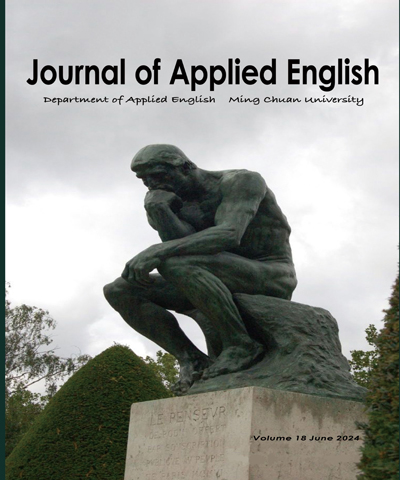
應用英語期刊/Journal of Applied English
銘傳大學應用英語學系所,正常發行
選擇卷期
- 期刊
This study investigates the effect of teaching English parts of speech constructions to non-English major students at a Taiwanese university. Word-class constructions were taught with a pre-test and post-test comparison. A paired one-tail t-test was employed to examine students' learning outcomes. Additionally, a questionnaire survey formed with a 5-point-Likert-type scale was distributed to collect participants' ideas about the teaching. Mean scores and a one-way ANOVA were employed to analyse the results. The paired t-test result points out there is a significant difference (p<.05) between students' pre-test and post-test scores, which suggests learning English parts of speech constructions can possibly improve students' English learning achievement. However, the questionnaire results not only report that students do not think their English is improved but also that learning parts of speech construction is less helpful. Students' lack of confidence may also influence their degree of agreement to the statements in the questionnaire survey.
- 期刊
Few studies have examined the effects of the five types of recasts categorized by Lyster (1998a) and Doughty and Valera (1998), the isolated declarative, the incorporated declarative, the isolated interrogative, the incorporated interrogative, and the corrective recasts. Similarly, more research is needed to explore English as a Foreign Language (EFL) students' noticing of the five types of recasts and how it affects their learning of implicit and explicit knowledge. This research investigated these types of recasts, involving a total of sixty EFL learners in college. Participants were randomly assigned to the five experimental groups and the control group. Data collection comprised a pre-test, the supplication of the five types of recasts on students' errors on the past unreal conditional, a noticing log, stimulated recall interviews, a post-test, and a delayed posttest. The learning of types of language knowledge was measured via an oral production task and an untimed grammaticality judgment test. Results of qualitative data illustrate that students most frequently notice incorporated declarative and corrective recasts. The findings of the oral production task are partially related to the types of recasts students noticed more frequently and show a short-term effect of the incorporated declarative and incorporated interrogative recasts on the development of implicit knowledge. Nevertheless, the results of the untimed grammaticality judgment test show no significant difference regarding the learning of the explicit knowledge. EFL learners' noticing, therefore, of different types of recasts positively affected their learning of implicit knowledge regarding the target language structure.
- 期刊
Counter-unidirectional anaphora refers to the fact that pronouns precede nouns. This paper analyses and discusses counter-unidirectional anaphora in terms of its syntactic features, generation and interpretation mechanism. Based on a complete description of the data, some relevant theoretical hypotheses are proposed. It is argued that English anaphora differs from Chinese anaphora in terms of syntactic distribution due to their different ways of generation. Nevertheless, they follow the same syntactic-semantic interpretation mechanism. That is, syntactic interpretation follows the Linearity Principle while semantic interpretation the Semantic Orientation Principle; like unidirectional anaphora, counter-unidirectional anaphora of the third person pronoun is subject to the same syntactic and semantic constraints and conforms to the Identifiability Principle, Thematic Hierarchy and Orientation Principle. Hence the socalled counter-unidirectional anaphora is not truly counter-unidirectional, for it strictly abides by the Unilinearity Principle, i.e., in terms of semantic interpretation, nouns precede pronouns, or rather, pronouns are bound in their relevant local domains. Furthermore, counter-unidirectional anaphora is subject to rigid syntactic constraints, i.e., it must conform to the Predicate- Internal Subject Generation Mechanism, and counter-unidirectional anaphora in attributive clauses must also conform to GCR, ECP and island constraints as well as the Binding Principles B and C and satisfy the Prominence Constraint, Feature Compatibility Constraint, and I-within-I Constraint.

